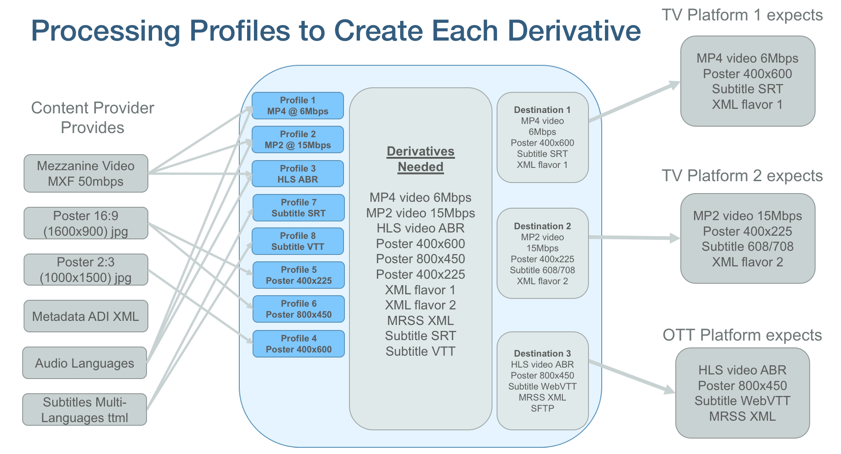
Whether content owner or service provider, the amount of time it takes to make content available in the required formats has consistently and significantly decreased. Today’s status quo is 24 hours or less for non-live broadcast offerings; however in many cases customers need it in less than six hours . This means that a finished “program” is transmitted via file-based terrestrial IP from a post house in Los Angeles to New York where it is then transcoded, packaged, and distributed. It’s not unusual for there to be 300 aggregation points (e.g. post houses and facilities from around the world), packaged into 150 different format permutations, and distributed to at least 100 worldwide partners.
This article talks about how to intelligently manage and distribute content to virtually any platform or screen—multiplied by the power of Watson. It includes an example around the logistics of VOD and OTT distribution and how it can function as part of a larger workflow as well. For more strategies and information around managing large libraries of content, also download this Video Metadata: Management and Tools white paper.
Use case sample
Let’s take a look at this complexity using real-world examples. A major content provider has a program that requires 93,000 different transcode runs which equate to 100-150 different formats. These are also time-based deliverables: depending upon the buyer contracts, there are significant penalties if service level agreements (SLAs) are not met.
To appreciate the scale, consider these nuances. The customer provides a package that consists of a video file, n number of audio files, thumbnails / poster art, and indicates the n number of distribution partners. Each partner – the content buyers – has specific deliverables. For example, Netflix, Apple, etc., indicate precise requirements for their platforms, and guidelines can easily run 40+ pages including items such as bitrates, frame rates, aspect ratios, etc.. With many different formats multiplied by these deliverable requirements, it’s easy to see the complexity of these tasks.
IBM’s Video Distribution and Workflow solutions offer a highly scalable ingest, packaging, and multi-platform distribution system for VOD and OTT. As Figure 1 shows, the solution was designed to handle all the workflows to transcode video assets, modify metadata and images, package media, and deliver it via IP on a worldwide basis. To provide some insight into the scale of these operations, in a one month period, a content provider ingested 3,013 assets and the solution created and delivered 125,256 unique packages from those assets. Proof of delivery, reporting, and asset tracking are extremely important to ensure that content is properly delivered and received, providing a streamlined, automated operation.

Figure 1. Content Provider assets which are ingested and then processed to create the needed derivatives.
Part of a larger workflow
Working in conjunction with IBM’s VOD & OTT distribution solution, Watson Captioning and Video Enrichment solutions provide additional functionality in an automated process. Watson Captioning is a highly scalable closed captioning offering while Watson Video Enrichment provides metadata extraction and enhancement such as time-stamped Speech-to-Text, Object and Concept Recognition, Sentiment Analysis and Semantic Scene Detection. As shown in the graphic, these routines can be managed by a Media Asset Management (MAM) system or by the solution itself.
To learn more about VOD & OTT distribution and other solutions from Watson Media, stop by Hall 7, Stand B25 at IBC 2018 or contact us and talk with a video expert.